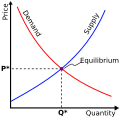| Part of the behavioral sciences |
| Economics |
|---|
 |
| |
| Part of a series on |
| Economic systems |
|---|
Major types |
In economics, industrial organization is a field that extends the theory of the firm by analyzing the structure of firms and markets, as well as the boundaries between them. It introduces real-world features that depart from the perfectly competitive model, such as transaction costs, [1] imperfect information, and barriers to entry faced by potential competitors.
Contents
- Subareas
- Market structures
- Areas of study
- History of the field
- See also
- Notes
- References
- Journals
- External links
The field studies how firms and markets are organized and how they behave across a spectrum ranging from competitive markets [2] to monopoly, [3] including cases shaped by government intervention and regulation.
Industrial organization combines theoretical models and empirical analysis to study issues such as market power, competition policy, oligopoly behavior, pricing strategies, vertical integration, and the design of contracts and institutions. It has applications in public policy, business strategy, and the regulation of industries.
There are different approaches to the subject. One approach is descriptive in providing an overview of industrial organization, such as measures of competition and the size-concentration of firms in an industry. A second approach uses microeconomic models to explain internal firm organization and market strategy, which includes internal research and development along with issues of internal reorganization and renewal. [4] A third aspect is oriented to public policy related to economic regulation, [5] antitrust law, [6] and, more generally, the economic governance of law in defining property rights, enforcing contracts, and providing organizational infrastructure. [7] [8]
The extensive use of game theory in industrial economics has led to the export of this tool to other branches of microeconomics, such as behavioral economics and corporate finance. Industrial organization has also had significant practical impacts on antitrust law and competition policy. [9]
The development of industrial organization as a separate field owes much to Edward Chamberlin, [10] Joan Robinson, Edward S. Mason, [11] J. M. Clark, [12] Joe S. Bain [13] and Paolo Sylos Labini, among others. [14] [15]